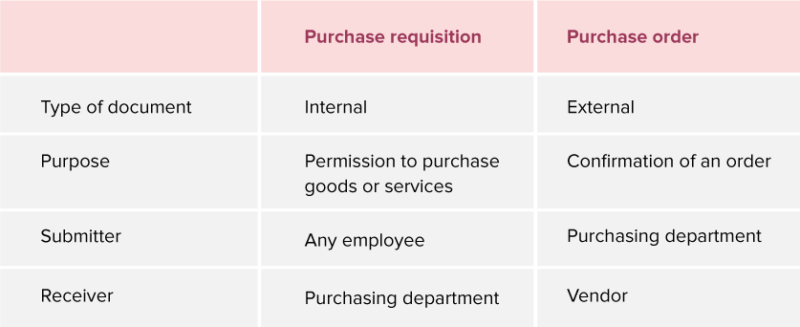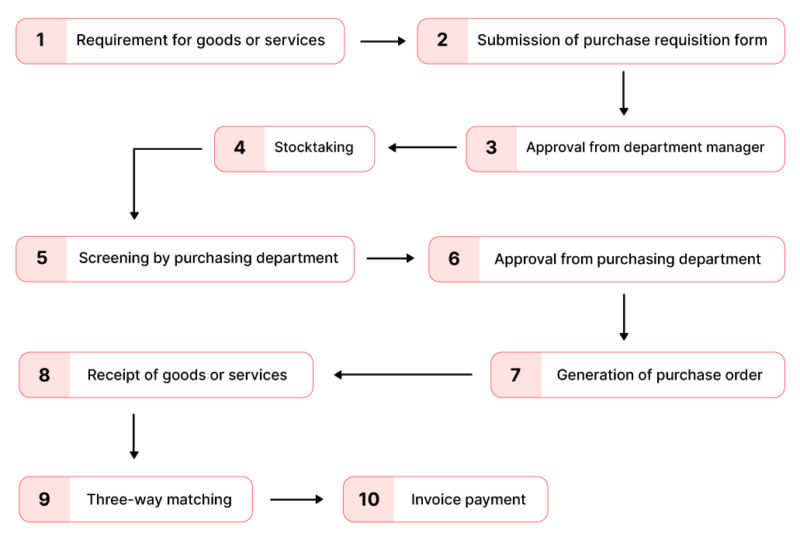Purchase requisition forms and purchase orders play vital roles in procuring goods and services for business needs. These key documents help standardize the purchasing process, both internally and externally. Together they assist teams in planning purchases based on set budgets, managing costs, and ensuring compliance with purchasing policies.
But sometimes, purchase requisition forms are mistaken for purchase orders and vice versa. This leads to misuse of the documents, or in some cases, the needed documents are not issued at all. In this guide, we will break down the purchasing process for easy understanding, cover the differences between purchase requisition forms and purchase orders, and explain their respective roles in the purchasing process.
Purchase requisition form
What is a purchase requisition form?
A purchase requisition form is a document submitted by an employee to request the purchase of goods or services on behalf of the company. These purchases may be for business operations, inventory, or to manufacture supplies for sale. Submitting a purchase requisition form sets off the purchasing process.
In this form, the employee lists the details of all the items they need from an external vendor, and they submit the form to their line manager and eventually the purchasing department for approval. The employee is actually not placing orders for goods or services, but rather asking for permission from the purchasing department to get the items.
Let’s say you head a manufacturing company. Per your company’s purchasing policy, employees must submit purchase requisition forms for purchases exceeding $2,000. A senior engineer in your team recommends a new piece of machinery which would automate a tedious task your firm has been performing manually. This particular piece of equipment costs $5,000, so the engineer must submit a purchase requisition form to their line manager.
Contents of a purchase requisition form
Purchase requisition forms include key details such as:
-
Name and department of the requester
- Name of the vendor
-
Date of request
-
Requester’s location
-
Purchase requisition number
-
Reason for purchase
-
Item description and quantity
-
Requested delivery date
-
Expected price of the purchase
When is a purchase requisition form needed?
Not all companies use purchase requisition forms in their purchasing process. Some use them only when the proposed purchase exceeds a specific amount. For small purchases, these companies allow internal departments to source the items directly from preferred vendors and complete payment using corporate credit cards, skipping the entire process of purchase requisition.
It is okay for companies to make purchase requisition forms optional, since they are not legal documents. A purchase requisition form is just an internal document that documents an employee’s request for items, and it has no value outside the firm. That means that each company can decide what kinds of purchases to require requisition forms for.
Purchase orders
What is a purchase order?
A purchase order is an external document that initiates the actual buying process. It is issued when the purchasing department approves the purchase requisition form. This document is then sent to the vendor of the goods or services. Once approved by both buying and selling parties, the purchase order becomes a legal financial contract.
Considering the manufacturing firm’s example, once the line manager and purchasing department have given their approval, a purchase order is issued and sent to the preferred vendor to procure the equipment.
Contents of a purchase order
Although purchase orders vary by business, they generally require the following information:
-
Name of your company
-
Date of issuance
-
Quantity, description, and price of the goods or services per unit
-
Delivery date
-
Billing details
-
Delivery address and invoice address of your company
-
Payment terms
-
Purchase order number
-
Signature of relevant stakeholders
When is a purchase order issued?
The purchasing department issues a purchase order once the purchase requisition form has been approved. However, if a company does not use purchase requisition forms, the requesting employees must issue purchase orders for approval. Purchase orders are external documents, but they can be used internally as well. For instance, interdepartmental purchases are common in large firms where one department purchases materials from another department. In these cases, the purchasing team would issue a purchase order, which is then used by the finance team to keep track of the individual budgets of the two departments.

The purchasing process
While the steps in a purchasing workflow may vary from one company to another, the basic outline of the process remains the same:

An employee recognizes the necessity for particular goods or services, and they request the purchase of the necessary items by filling out a purchase requisition form. The department’s line manager is notified when an employee submits a purchase requisition form. The line manager then checks the legitimacy of the purchase and ensures that its price falls within the department’s spending limit. Once the line manager approves the request, the form is passed to the inventory department. They check for the requested items in the existing stock, and if the items are not already in stock, they forward the form to the purchasing department.
At the purchasing department, the purchasing manager processes the request. They identify the business need for the requested items, check the legitimacy of the purchase, and confirm that the form has been approved by the requester’s manager. Once the purchase requisition form is approved by the purchasing department, it is converted to a purchase order and sent to the preferred vendor. To keep the process simple and organized, purchase orders usually have the same number as the associated purchase requisition forms, and they are filed together.
Once the contract negotiation process is complete, the vendor accepts the purchase order, and it becomes a legally binding contract between them and the buyer.
When the products or services are delivered by the vendor, a three-way matching process is carried out by the receiving team, in which they check the purchase order, order receipt/packaging slip, and invoice to confirm the accuracy of the order. If an item or service does not pass the quality check, the receiving team processes a return. Once all the documentation requirements are met, the purchase is closed. Next, the accounting team approves the invoice, enters it into the accounts payable records, and pays it according to the terms and conditions.
Why are purchase requisition forms and purchase orders important in procurement?
Purchase requisition forms and purchase orders play key roles in business spend management. In the absence of these documents, your company’s procurement workflow can become disorganized, with consequences ranging from minor losses to serious consequences. That is why companies of all sizes, from SMEs to enterprises. need purchase requisition forms and purchase orders. They standardize the procurement process, help in managing costs and inventory, prevent expense fraud, and protect the company during audits.
While there are different methods to create and manage purchase requisition forms and purchase orders, the ideal way is to have an e-procurement system in place. If you’re handling your purchasing process manually, it may be difficult to find out which employee purchased what items and when. By switching to an automated system for issuing, forwarding, and tracking these documents, you can streamline the purchasing process, save a great deal of time and money, and make your business more secure.
 1
1
very informative very professional and simple language